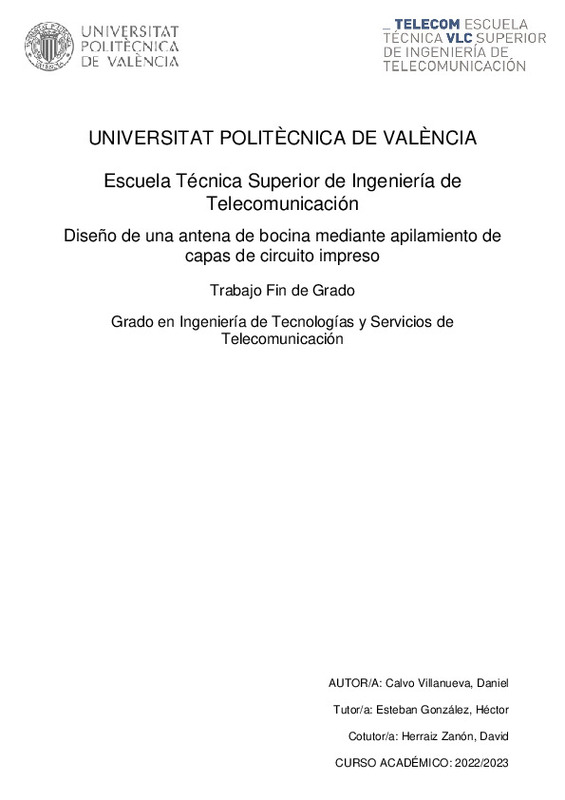JavaScript is disabled for your browser. Some features of this site may not work without it.
Buscar en RiuNet
Listar
Mi cuenta
Estadísticas
Ayuda RiuNet
Admin. UPV
Diseño de una antena de bocina mediante apilamiento de capas de circuito impreso
Mostrar el registro sencillo del ítem
Ficheros en el ítem
| dc.contributor.advisor | Esteban González, Héctor
|
es_ES |
| dc.contributor.advisor | Herraiz Zanón, David
|
es_ES |
| dc.contributor.author | Calvo Villanueva, Daniel
|
es_ES |
| dc.date.accessioned | 2023-07-26T14:54:05Z | |
| dc.date.available | 2023-07-26T14:54:05Z | |
| dc.date.created | 2023-07-21 | es_ES |
| dc.date.issued | 2023-07-26 | es_ES |
| dc.identifier.uri | http://hdl.handle.net/10251/195563 | |
| dc.description.abstract | [ES] El creciente auge del sector espacial ha impulsado el desarrollo de nuevas tecnologías para satisfacer las necesidades de los satélites de pequeñas dimensiones. Estos satélites requieren dispositivos compactos, de bajo perfil y fácil fabricación. Para abordar este desafío, se ha investigado el uso de líneas vacías integradas en sustrato, las cuales presentan características similares a las estructuras tridimensionales (como guías y coaxiales), pero con la ventaja de mantener un bajo coste y perfil, lo que las hace adecuadas para las necesidades actuales. En concreto, la guía de onda vacía integrada en sustrato (Empty Substrate Integrated Waveguide - ESIW) permite integrar una guía de onda convencional en un substrato. En esta prometedora tecnología, se han desarrollado muchos componentes como filtros, transiciones, y bocinas en plano H, que se pueden encontrar en un sistema convencional de comunicaciones. No obstante, no han sido desarrolladas bocinas piramidales, por lo tanto, el objetivo de este trabajo final de grado es el desarrollar una bocina piramidal apilando substratos, a los cuales se le hará alguna modificación, si es necesario, con el fin de mejorar la adaptación. Para ello, el alumno deberá de entender el fundamento de las líneas vacías integradas en substrato, y el fundamento de las bocinas. Para los diseños, deberá de aprender a utilizar el simulador electromagnético comercial CST y el uso de Matlab como ayuda para realizar los cálculos necesarios. Los diseños se realizarán teniendo en cuenta las posibles limitaciones a nivel de fabricación, y por último si es posible se validarán los diseños mediante fabricación y medida. | es_ES |
| dc.description.abstract | [EN] The growing space sector boom has driven the development of new technologies to meet the needs of small satellites. These satellites require compact, low-profile and easy-to-fabricate devices. To address this challenge, the use of substrate-integrated empty lines has been investigated, which exhibit similar characteristics to three-dimensional structures (such as waveguides and coaxials), but with the advantage of maintaining a low cost and profile, making them suitable for today's needs. In particular, the Empty Substrate Integrated Waveguide (ESIW) allows a conventional waveguide to be integrated into a substrate. In this promising technology, many components such as filters, transitions, and H-plane horns, which can be found in a conventional communications system, have been developed. However, pyramidal horns have not been developed, therefore, the objective of this final degree work is to develop a pyramidal horn by stacking substrates, to which some modification will be made, if necessary, in order to improve the adaptation. For this, the student will have to understand the fundamentals of substrate-integrated empty lines and the fundamentals of horns. For the designs, the student will have to learn how to use the commercial electromagnetic simulator CST and the use of Matlab as an aid to perform the necessary calculations. The designs will be made taking into account the possible limitations at the manufacturing level, and finally if possible the designs will be validated by fabrication and measurement. | en_EN |
| dc.format.extent | 68 | es_ES |
| dc.language | Español | es_ES |
| dc.publisher | Universitat Politècnica de València | es_ES |
| dc.rights | Reserva de todos los derechos | es_ES |
| dc.subject | Antena | es_ES |
| dc.subject | Circuitos planares | es_ES |
| dc.subject | Guía integrada integrada en sustrato | es_ES |
| dc.subject | Antenna | en_EN |
| dc.subject | Planar circuits | en_EN |
| dc.subject | Substrate Integrated Waveguide | en_EN |
| dc.subject.classification | TEORÍA DE LA SEÑAL Y COMUNICACIONES | es_ES |
| dc.subject.other | Grado en Ingeniería de Tecnologías y Servicios de Telecomunicación-Grau en Enginyeria de Tecnologies i Serveis de Telecomunicació | es_ES |
| dc.title | Diseño de una antena de bocina mediante apilamiento de capas de circuito impreso | es_ES |
| dc.title.alternative | Design of a horn antenna using stacked printed circuit layers | es_ES |
| dc.title.alternative | Disseny d'una antena de bocina apilant capes de circuit imprés | es_ES |
| dc.type | Proyecto/Trabajo fin de carrera/grado | es_ES |
| dc.rights.accessRights | Abierto | es_ES |
| dc.contributor.affiliation | Universitat Politècnica de València. Departamento de Comunicaciones - Departament de Comunicacions | es_ES |
| dc.contributor.affiliation | Universitat Politècnica de València. Escuela Técnica Superior de Ingenieros de Telecomunicación - Escola Tècnica Superior d'Enginyers de Telecomunicació | es_ES |
| dc.description.bibliographicCitation | Calvo Villanueva, D. (2023). Diseño de una antena de bocina mediante apilamiento de capas de circuito impreso. Universitat Politècnica de València. http://hdl.handle.net/10251/195563 | es_ES |
| dc.description.accrualMethod | TFGM | es_ES |
| dc.relation.pasarela | TFGM\155684 | es_ES |
Este ítem aparece en la(s) siguiente(s) colección(ones)
-
ETSIT - Trabajos académicos [2408]
Escuela Técnica Superior de Ingenieros de Telecomunicación






